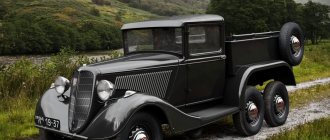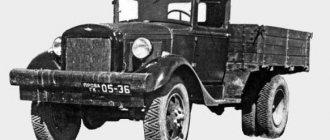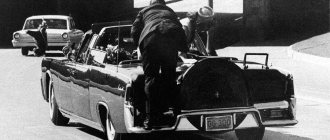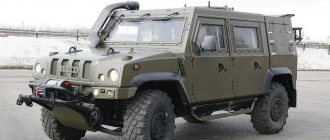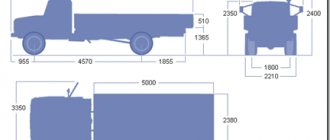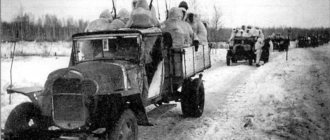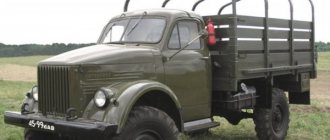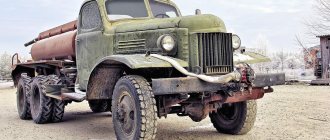ZIL-4102
In the mid-80s, the winds of change blew in the Soviet Union. The new General Secretary, Mikhail Gorbachev, led the country on a new course of restructuring, acceleration and democratization. Among other things, the history of the new generation Soviet executive car, which was developed in the 80s, but never went into production, is also connected with the figure of the first and last president of the USSR. The creation of this machine was carried out by specialists from the Likhachev plant; the first prototype was ready by 1988. The car received the designation ZIL-4102.
Compared to the heavyweight representatives of the ZIL-4104 line, the new limousine was lighter, more compact, and more democratic. Based on the ZIL-4102 car, they planned to create a whole family of executive and special vehicles. But it didn’t come true... The General Secretary did not like the product of Zilov’s designers, so the car never made it into the series. Alas, sometimes the result of many years of painstaking work of an entire team depends on the whim or tyranny of one person endowed with supreme power.
In total, two prototypes of the new car were made; the factory workers gave them names in honor of the reformer secretary general and his first lady. And they did it in the most familiar manner possible: the limousines received the names “Mishka” and “Raika”. The black “Bear” (No. 001) was lost many years ago, all that remained of it was the “face” with a bumper, radiator grille and headlights. The only surviving example of this government sedan is the light brown Raika (No. 002). They say that today it is in one of the private collections. In general, the project to create a limousine for the last Soviet general secretary can be called one of the most little-known pages in the history of the domestic automobile industry.
All that remains of “Mishka” - car ZIL-4102 No. 1
ZIL-4102 car for the last president of the USSR
The power unit was much more traditional for ZIL vehicles.
To ensure the specified technical characteristics, the ZIL-4102 was equipped with a powerful 315-horsepower eight-cylinder engine of the ZIL-4104 model. Thanks to the cylinder volume of about 8 liters, it had a fairly high torque (up to 62 kgf/m). A four-chamber K 259 carburetor was used to supply fuel. The engine was transferred practically unchanged from the previous model. The main difference from the limousine engine was the contactless ignition system. The gearbox - a classic three-speed hydraulic automatic model 4105-01 - was identical to the ZIL-41047 gearbox. Thanks to the powerful motor, the dynamic and technical characteristics of the ZIL-4102 (the photo below shows the general view of the power unit) have increased significantly. As a result, they turned out to be higher than those of the previous generation limousine.
Technical characteristics of ZIL-4102:
- The maximum speed of the car reached 200 km/h.
- Acceleration dynamics – 10.5 seconds to 100 km/h.
- Fuel consumption is an average of 18 liters/100 km.
Since the car had an independent rear suspension, a CV joint was used to drive the wheels. The rear wheel drive gearbox was rigidly mounted on the subframe.
Design and design of ZIL-4102
The car received a unique design, which was significantly different from previous domestic premium designs. A supporting body appeared. The engineers did not use the old generation platform; they developed a new and unique one. This made it possible to get rid of the large structure, making the car more compact and more dynamic.
The body has become lighter and stiffer. This was made possible through the use of fiberglass for the manufacture of panels for the underbody, roof, hood and trunk. The rear and front windshields were attached to the openings using a special, heavy-duty glue. Aerospace-grade adhesive was used to attach the roof panels to the frame.
Independent spring suspension on all wheels was an innovation for the Russian automotive industry. The suspension design was complemented by load-bearing subframes with an “anti-stick” effect. The front suspension was based on double wishbone technology. The rear suspension design is based on the Mercedes kinetic scheme. Some Rolls-Royse technology has been applied to improve the quality of the rear subframe. The increase in brake mechanisms led to an increase in wheel discs - they received a 17-inch size. Each wheel was equipped with disc brakes with floating calipers.
The power unit and hydromechanical transmission, compared to the last generation, have not received any changes. The ZIL-4104 motor has the following characteristics:
- Volume - 7.7 liters;
- Number of cylinders - 8;
- The cylinder arrangement is V-shaped;
- Engine type - carburetor;
- Carburetor - four-chamber;
- Power - 315 horsepower at 4.4-4.6 thousand rpm.
The latest update 41047 received a contactless ignition system. The innovative development was transferred to the new generation of government cars. The power plant gave the lightweight sedan the qualities of a sports car. Constant velocity joints were responsible for driving the rear wheels. The rear axle is made of a split type - the gearbox housing is fixedly mounted on a separate subframe using elastic supports.
The designers simplified the interior of the cabin, but did not make it less representative. To make passengers feel comfortable, special attention was paid to sound and thermal insulation. To do this, the engine was enclosed in a special capsule that reduces noise in the cabin. After numerous tests, the designers managed to completely eliminate vibration from the body panels. The ZIL-4102 car lost its glass partition. Instead, the ability to electrically adjust two sections of the rear sofa, which can accommodate three people, has been added. A unique feature was the presence of an on-board computer with a voice notification function. It was developed by German specialists to a special order from ZiL.
The front optics were borrowed from the Swedish company Volvo (in those years ZIL and Volvo collaborated closely). The headlights were taken from the first Volvo-850 prototype (the series later received different headlights). Thanks to the remaining powerful power plant and reduced weight, it was possible to improve acceleration to 100 km/h - the new sedan needed 10.5 seconds. Average fuel consumption was 18-21 liters per 100 kilometers, depending on the average speed.
Suspension and brakes
For the first time, independent suspension on all wheels was introduced for ZIL passenger cars. Springs with the function of damping “dive” during acceleration and braking were used as shock-absorbing elements. When developing suspensions, the experience of the world's leading automotive concerns was used. The suspension units were assembled on separate subframes. The steering mechanism with a “screw and gear sector” type gearbox was equipped with a hydraulic booster.
The rear suspension was equipped with oblique trailing arms and a stabilizer. The front suspension did not have kingpins in its design and was also equipped with a stabilizer.
A heavy and dynamic car needed a powerful braking system. All brake mechanisms on ZIL-4102 are disc. Due to the increased diameter of the brake discs, the car received new 17-inch wheels. The old 16-inch wheels simply did not accommodate the new brake mechanisms. The hydraulic brake drive had three boosters - one vacuum and two hydraulic vacuum.
Design and arrangement of the car interior ZIL-4102
ZIL-4102 is a four-door sedan with a front engine and driven rear wheels. Although the car turned out to be 500 kg lighter than the ZIL-41041, its dimensions were still very impressive: the length was half a meter longer than the serial Volga. It can also be added that the appearance of the ZIL-4102 was very different from the executive cars produced at the plant named after. Likhachev earlier.
The main design features of the car are the monocoque body and the absence of a frame, which led to a high level of vibration. The designers could not solve this problem for a long time, but in the end they achieved victory by reducing the oscillations to an acceptable 25-28 Hz. To reduce noise, the engine and gearbox were covered with special covers.
Under the hood of ZIL-4102
All parts of the ZIL-4102 body were made and adjusted by hand; 10-15 layers of paint were applied to each of them, with each layer always dried and polished. Composite materials were widely used in the design of the ZIL-4102, which can be called a novelty for the domestic automobile industry. The bottom and roof panels, bumpers, hood and trunk lid were made from fiberglass. This solution made it possible to reduce the total weight of the vehicle.
The rear and windshield were attached using special glue, and the roof panel was installed in the same way.
The car's interior was designed for four people, including the driver and a security guard, whose seat was in the front. There were no folding seats for security, as on previous ZIL vehicles. The rear seats were separate and could be adjusted electrically. They were separated from the front seats by a massive floor partition with retractable foot rests.
On the rear ceiling of the cabin there was a control panel for air conditioning and lighting. The air conditioning system included two independent climate control units.
The upper part of the interior was trimmed with velor and light-colored leather, the lower part was covered with dark carpet.
Nameplate from ZIL-4102
New solutions in body design
The ZIL-4102 car with a sedan body fully corresponded to the wishes of the Secretary General. But the time frame for building the first sample was very tight - no more than 6 months were allotted for all work. Due to tight deadlines, development of design and construction solutions was carried out on a full-size sedan mock-up.
As a result, the design team led by E.D. Gusev managed to create a car with solutions that were completely uncharacteristic of ZIL products. To facilitate the design, the body of the ZIL-4102 was made according to a load-bearing design. Composite materials were used in the design of a number of body parts, which increased body rigidity and further reduced weight. As a result, the curb weight of the vehicle was 3.25 tons. Considering the overall dimensions of the machine, the weight indicator is very good.
Additional strength was given to the body by the windshield and rear windows glued into the openings. Adhesive joints were used to connect some body parts. Description of ZIL-4102 will not be complete without mentioning the high quality of sound insulation of the body. The engine and transmission were covered with a special casing, which reduced noise and prevented dust from entering components and assemblies. External body panels, prone to vibration, were covered with soundproofing materials and equipped with structural reinforcements.
If Suzuki Jimny spoke Russian. NAMI-LuAZ "Proto"
It is no coincidence that this car can be compared with the popular Japanese one. It could go into production, because all the requirements for the car were met. Passable, reliable SUV, as comfortable as a passenger car. Metal frame body, economical engine and many opportunities for garage mechanics to modernize the car. Unfortunately, Moscow actively promoted AvtoVAZ in those years, and all developments that could draw buyers away from the promising plant were cut down in the bud. Do we regret this? Everyone will answer for themselves.
Light passenger cars ZIL
Previously, category “C” included vehicles intended for the transportation of goods with a gross weight of more than 3,500 kg. But since 1998, the driver’s license has written in black and white: “Vehicles, with the exception of those belonging to category “D”, the permissible maximum weight of which exceeds 3500 kg.” This means that to drive any car heavier than three and a half tons, but with no more than eight seats, you need a “cargo category”. However, the introduction took a little too long...
Unfortunately, in the year of the centenary of the legendary Likhachev plant, we can only remember it. But, I think, many will be interested in learning a few facts and interesting stories about how ZIL passenger cars were created, modernized and tested already at the end of their production - limousines of the first persons of the state, which, out of habit, people called “member carriers”, because in 1960–1980 -x only senior members of the CPSU Central Committee could use them, and in the 1990s only members of the government.
I joined the division called the “bureau for research and development of passenger cars, light-duty and special vehicles”, which was part of the CEIR structure (corps of experimental and research work) immediately after graduating from the Moscow Automobile and Highway Institute MADI (GTU) in the summer of 1998 as a driver - tester “5/25”. Here is the first intrigue in my starting position at AMO ZIL.
Design and arrangement of the car interior ZIL-4102
ZIL-4102 is a four-door sedan with a front engine and driven rear wheels. Although the car turned out to be 500 kg lighter than the ZIL-41041, its dimensions were still very impressive: the length was half a meter longer than the serial Volga. It can also be added that the appearance of the ZIL-4102 was very different from the executive cars produced at the plant named after. Likhachev earlier.
The main design features of the car are the monocoque body and the absence of a frame, which led to a high level of vibration. The designers could not solve this problem for a long time, but in the end they achieved victory by reducing the oscillations to an acceptable 25-28 Hz. To reduce noise, the engine and gearbox were covered with special covers.
Under the hood of ZIL-4102
All parts of the ZIL-4102 body were made and adjusted by hand; 10-15 layers of paint were applied to each of them, with each layer always dried and polished. Composite materials were widely used in the design of the ZIL-4102, which can be called a novelty for the domestic automobile industry. The bottom and roof panels, bumpers, hood and trunk lid were made from fiberglass. This solution made it possible to reduce the total weight of the vehicle.
The rear and windshield were attached using special glue, and the roof panel was installed in the same way.
The car's interior was designed for four people, including the driver and a security guard, whose seat was in the front. There were no folding seats for security, as on previous ZIL vehicles. The rear seats were separate and could be adjusted electrically. They were separated from the front seats by a massive floor partition with retractable foot rests.
On the rear ceiling of the cabin there was a control panel for air conditioning and lighting. The air conditioning system included two independent climate control units.
The upper part of the interior was trimmed with velor and light-colored leather, the lower part was covered with dark carpet.
Nameplate from ZIL-4102
All multimedia systems that existed at the time of the car's release were available to passengers. In the cabin there were:
- digital tuner;
- cassette player;
- audio system consisting of ten speakers.
In addition, the ZIL-4102 was equipped with an on-board computer with a voice synthesizer, which was specially ordered in Germany.
The limousine had three-layer athermal windows, which were lowered and raised using electric lifts.
How a limousine was created for the last Soviet Secretary General
In the mid-80s, the main limousine for the Soviet party nomenclature was the ZIL-4104 and its modifications - ZIL-41045 and ZIL-41047. It was a truly monumental car - a real symbol of the Soviet empire, as strict and official as possible. At the time of its adoption, the ZIL-4104 was the longest production vehicle in the world. Not only did it carry the top of the country, a large number of special modifications were created on the basis of this limousine, including a security vehicle, a VIP ambulance, and special communications vehicles. However, already in the early 80s, the ZIL-4104 began to gradually become obsolete.
During the creation of the car, designers had to create many mock-ups. This is one of them.
There is an opinion that the direction for the development of ZIL-4102 was given personally by the new General Secretary of the CPSU Central Committee, Mikhail Gorbachev, but this is not entirely true. The designers of the Likhachev plant began implementing this project back in 1982. It was planned to replace the five-seater ZIL-41041 sedan with a new car. At the same time, work was underway on an extended modification of the car with a limousine body, but in this case it did not even get to the point of creating a prototype. The car project was led by E.D. Gusev, the chief designer of the plant.
The development of the concept of the new car was difficult. For study - or copying - a British Rolls-Royce Silver Spirit limousine was purchased, the features of which can be easily seen in the appearance of the ZIL-4102. At the same time, the Soviet limousine is somewhat subtly similar to the Volvo 760 and the American Cadillac Fleetwood Limousine.
During the implementation of the project, a large number of mock-ups were made, on which not only the design of the future car was worked out, but also its aerodynamic shape was improved. The final design concept for the car was formed only in 1985.
As a result, the order for the production of two experimental cars was transferred to the sixth workshop of the enterprise, which was engaged in the manufacture of products for Soviet VIPs.
What happened next?
The first copies were prepared by May 1988. The first demonstration was held for the Chairman of the Council of Ministers of the USSR I.S. Silaeva. He liked the new generation of cars. After this, the transport was demonstrated to the president, but he was not satisfied with the new development. Gorbachev did not express specific complaints, saying a general “Something is not right...”. The company's engineers did not understand what to do with such an assessment. Previously, the head of the country either accepted the car or sent it for modification, after which serial production began.
Despite the lack of specifics, prototypes continued to be tested at factory sites and improvements were made to the design. In August 1991, due to the difficult situation in the country, it became clear that the project would not receive demand. When the country began to move to a market system, ZiL could independently begin producing a new sedan and limousine. To do this, it was necessary to find financing, and then customers to purchase expensive vehicles, which is practically impossible in a crisis. The project was closed, the limousine was disposed of, and the sedan, after many years of inactivity at the plant, went to the private collection of a Lukoil top manager.
The collapse of the Soviet “democratic” limousine
In 1988, the project was finally realized in metal. ZIL employees hoped that the creation of a new, more democratic and modest executive car would fit perfectly into the state discourse of the fight against the luxury of the nomenklatura. The prototypes were demonstrated to the delegates of the XIX Party Conference and personally to the Secretary General.
However, Mikhail Sergeevich did not like the new car, after which the project was immediately curtailed and rather quickly forgotten. It is possible that such a decision was dictated not only by the subjective opinion of the Secretary General, but also had other, much more important reasons. At the end of the 80s, the Soviet economy was already on its last legs, so, probably, there was simply no money for mass production of a new passenger car.
Inside the cabin of ZIL-4102. Compared to other Soviet limousines, it really looks modest and democratic.
But the plans for the ZIL-4102 were grandiose. On the basis of this car they wanted to create a whole family of cars: from a basic modification intended for transporting regional nomenclature, to armored limousines for senior officials of the state. Moreover, thanks to the trends of new times, the ZIL-4102 could easily go on sale. Of course, an ordinary Soviet citizen was unlikely to be able to buy it, but for famous artists, athletes, and writers it would be quite affordable. At ZIL, for the large-scale production of this machine, they planned to radically re-equip production, purchase new machines and increase staff. Thus, it was planned to increase the number of cars produced to thousands of copies.
ZIL-4102 was eventually planned to be released for free sale
There is unconfirmed information that the developments obtained during the creation of the ZIL-4102 were later used in the “Cortege” project.
ZIL for the last president of the USSR. The history of the premium 4102, which never went into production.
Good day everyone, and today I want to tell you about one rather interesting ZIL, which did not go into production, although it looked quite promising.
And so, let's go!
History of creation
It all started with the ZIL 41047 model, which at that time was transferred to Gorbachev, who independently drove this car, without any personal drivers, etc. When Mikhail had already driven around and decided that he needed an updated car, the state entered ZIL. order. Then the engineers of the Likhachev Plant began to develop a new limousine for senior officials. The first samples appeared already in 1895 and then it was planned to create a version of the limousine 4101 and a slightly shorter car - 4102. Since it was the state. order, then the employee literally had to work as a laborer seven days a week in order to have time to create the 4102nd.
Design and technical component
I'll start with the design.
I think many have already noticed that the car was radically different from previous executive class limousines for the government. And all because a new platform was developed, and not as usual. Quite a lot of plastic was used to create the car. As a result, the body was made more rigid, but at the same time lighter. When creating the suspension, technologies and designs from companies such as Mercedes and Rolls-Royce were used. And yes, the headlights used here were from a Volvo 850, so it’s not your imagination.
Salon.
It is worth noting that the interior is quite good. For example, the sound insulation here was several levels higher than that of previous similar cars. The car also had an on-board computer, which was developed to order by a German company. Well, the interior itself was slightly simplified, but this did not make it worse, but on the contrary, only better.
Motor.
In fact, they decided to leave the engine the same, and, in principle, the transmission too. Here are its main characteristics:
- Power:
315 hp - Engine:
V8. - Volume:
7.7 liters. - Acceleration from 0 to 100 km/h:
10.5 seconds. - Fuel consumption:
18-22 liters per 100 kilometers.
Further fate
The first complete cars were assembled in May 1988. True, Gorbachev did not like the car and he said: “Something is wrong. ". Engineers and designers still did not understand what was wrong with the car, but at the same time they continued to test these copies. Well, we all know very well what happened in 1991. Then this limousine simply became unnecessary to anyone, but ZIL had a chance. He had the right to start production on his own, although they needed investors, of whom there were none. And in the end, the car never went into production. Now there is only one such ZIL left and it belongs to the manager of Lukoil.
That's all. Write your opinion about this car in the comments.
First and last samples
The first two running samples of the car were assembled by workshop No. 6 in May 1988, meeting the prescribed deadlines. One of the cars had a classic black color, the second was painted metallic gold. Some elements of the car were borrowed. An example would be the headlights from the Volvo 850 prototype (at that moment ZIL and ZIL were actively working together). Much less chrome was used in the exterior design of the cars than in the previous ZIL-41047. The running tests of the prototypes were generally successful, showing the viability of the car.
However, the machines did not completely satisfy the main customer - M. Gorbachev. In his traditional manner, he did not give a clear assessment of the project, so the plant continued to work on the project. Among the plant workers, the machines were nicknamed “Mishka” and “Raika”.
If Suzuki Jimny spoke Russian. NAMI-LuAZ "Proto"
It is no coincidence that this car can be compared with the popular Japanese one. It could go into production, because all the requirements for the car were met. Passable, reliable SUV, as comfortable as a passenger car. Metal frame body, economical engine and many opportunities for garage mechanics to modernize the car. Unfortunately, Moscow actively promoted AvtoVAZ in those years, and all developments that could draw buyers away from the promising plant were cut down in the bud. Do we regret this? Everyone will answer for themselves.
